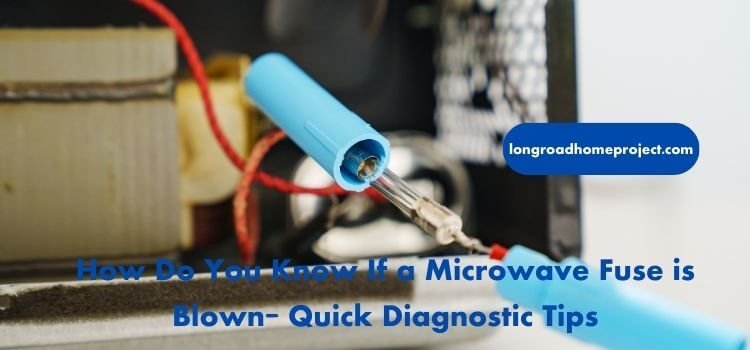As an Amazon Associate I earn from qualifying purchases.
To know if a microwave fuse is blown, check for visible damage or test it with a multimeter. A blown fuse will show no continuity.
A microwave fuse is a crucial component that protects your appliance from electrical surges. If your microwave suddenly stops working, a blown fuse might be the culprit. Inspecting the fuse for signs of damage can quickly determine if it’s blown.
Use a multimeter to test the fuse’s continuity; a working fuse will show continuity, while a blown one will not. Replacing a blown fuse is usually straightforward, but always ensure the microwave is unplugged before attempting any repairs. Identifying and replacing a blown fuse can save you from costly repairs or replacements.

Introduction To Microwave Fuses
Microwave fuses are small but essential components. They protect your microwave from damage. If your microwave stops working, a blown fuse might be the cause. Knowing how to check the fuse can save time and money.
Purpose Of Microwave Fuses
Microwave fuses are safety devices. They prevent electrical overloads. When too much power flows, the fuse blows. This stops the microwave from getting damaged. Fuses keep your microwave and home safe.
Common Fuse Types
There are different types of microwave fuses. The most common types are:
- Ceramic Fuses
- Glass Fuses
Ceramic fuses are more durable. They handle higher temperatures better. Glass fuses are easier to inspect. You can see if they are blown.
How To Identify A Blown Fuse
A blown fuse can be identified by a few methods. If the microwave has no power, check the fuse. A blackened or broken fuse is a clear sign. Use a multimeter to test the fuse. No continuity means the fuse is blown.
Symptoms Of A Blown Fuse
A microwave with a blown fuse will show clear symptoms. Recognizing these symptoms can save you time and effort. Here are some signs to look for.
Microwave Not Powering On
One of the main signs is the microwave not powering on. If the microwave does not start, check the fuse. A blown fuse can prevent the microwave from turning on at all.
Display And Light Issues
Another sign includes issues with the display and lights. The display may be blank, and the interior light might not work. This can indicate a blown fuse. If the display and lights do not work, check the fuse.
Safety Precautions
Before checking if a microwave fuse is blown, follow safety precautions. These steps ensure you avoid electrical shocks and other hazards.
Unplugging The Microwave
First, unplug the microwave from the power source. This is crucial to prevent electric shocks. Do not skip this step.
Double-check that the microwave is completely unplugged. Look at the power cord and ensure it is not connected to any outlet.
Using Protective Gear
Next, wear protective gear to stay safe. Use rubber gloves to prevent electrical shocks. Rubber gloves are essential when handling electrical components.
Consider wearing safety glasses to protect your eyes. Sometimes, small parts can fly out unexpectedly. Safety glasses help keep your eyes safe.
Additionally, use insulated tools for any work inside the microwave. Regular tools can conduct electricity and cause harm. Insulated tools are specifically designed to handle electrical tasks safely.
These precautions are simple but vital. Always prioritize safety when dealing with electrical appliances.

Locating The Fuse
Finding the microwave fuse can be tricky. It’s essential to locate it correctly. This guide helps you find the fuse quickly and safely.
Consulting The User Manual
First, refer to the user manual. The manual provides specific details about your microwave model. Look for a section about fuses. It often includes diagrams or pictures. These visuals make locating the fuse easier.
If you don’t have the manual, check the manufacturer’s website. They often have digital copies available for download. Make sure you search for your exact microwave model.
Common Fuse Locations
Microwave fuses are usually in a few common locations. Here are the most frequent spots:
- Behind the control panel
- Near the power cord entry point
- Inside the microwave’s back panel
To access these areas, you may need to remove some screws. Always make sure the microwave is unplugged before attempting to access any internal parts.
Use a multimeter to check if the fuse is blown. If the multimeter shows no continuity, the fuse needs replacing. Always replace it with the exact type and rating specified in the manual.
| Model | Fuse Location |
|---|---|
| Model A | Behind the control panel |
| Model B | Near the power cord entry point |
| Model C | Inside the back panel |
Remember to handle all components with care. Safety should always be your top priority.
Testing The Fuse
Suspect your microwave fuse is blown? Testing it is simple. Follow these steps to ensure your fuse is functioning properly. You can either perform a visual inspection or use a multimeter for accuracy.
Using A Multimeter
A multimeter helps you check the fuse with precision. First, set your multimeter to the continuity or ohms setting.
- Unplug the microwave and remove the fuse.
- Place the multimeter probes on each end of the fuse.
- If the multimeter beeps or shows a reading, the fuse is good.
- If there is no sound or reading, the fuse is blown.
| Multimeter Reading | Fuse Condition |
|---|---|
| Continuity Beep or Reading | Good Fuse |
| No Continuity or Reading | Blown Fuse |
Visual Inspection
Sometimes, you can tell if a fuse is blown just by looking. Here’s how to do a visual inspection:
- Remove the fuse from the microwave.
- Check the glass tube of the fuse.
- Look for a broken filament or dark burn marks.
- If you see these signs, the fuse is blown.
- If the filament is intact, the fuse is likely good.
Performing these checks can help you determine the condition of your microwave fuse. Replace it if necessary to keep your microwave running smoothly.
Replacing The Fuse
If your microwave stops working, the fuse might be blown. Replacing the fuse can fix this issue. Follow these steps to safely replace the fuse and get your microwave working again.
Choosing The Right Fuse
First, you need to choose the right fuse. Look at the old fuse to find the correct type. You can find the fuse rating on the side of the fuse. It will show numbers like 20A or 15A. This tells you the amount of current the fuse can handle.
You should also check the voltage rating. This will be shown as 125V or 250V. Make sure the new fuse matches these numbers. You can buy a new fuse at a hardware store or online.
Steps To Replace
- Unplug the microwave to avoid electric shock.
- Locate the fuse holder inside the microwave.
- Use a screwdriver to open the microwave’s back panel.
- Find the blown fuse and carefully remove it.
- Insert the new fuse into the holder.
- Reattach the back panel with the screwdriver.
- Plug the microwave back in and test it.
If the microwave works, the fuse replacement was successful. If not, there might be another issue.
Preventing Future Issues
Keeping your microwave in good condition is vital for long-term use. Preventing issues can save time and money. Here are some tips to avoid blown fuses and other problems.
Regular Maintenance Tips
Regular maintenance can extend the life of your microwave. Follow these tips to keep it running smoothly:
- Clean the microwave inside and out every week.
- Inspect the door seal for any damage.
- Check the turntable for smooth operation.
- Remove and clean the filter if your microwave has one.
- Look for signs of wear on the power cord.
Proper cleaning helps prevent overheating. A clean microwave is less likely to malfunction.
Avoiding Overloads
Avoiding overloads can prevent blown fuses. Here are some tips:
- Do not use multiple appliances on the same circuit.
- Avoid using metal objects inside the microwave.
- Do not run the microwave empty. It can cause damage.
- Use microwave-safe containers to avoid sparks and fires.
- Follow the manufacturer’s guidelines for usage and care.
Overloading the microwave can cause electrical issues. Always ensure the microwave has enough ventilation.
| Maintenance Task | Frequency |
|---|---|
| Clean interior and exterior | Weekly |
| Inspect door seal | Monthly |
| Check turntable | Monthly |
| Clean filter | Monthly |
| Inspect power cord | Quarterly |
By following these simple tips, you can avoid future issues. Regular checks and careful use can keep your microwave working well for years.
When To Call A Professional
Knowing when to call a professional can save time and money. Microwave repairs can be tricky and dangerous. Let’s explore when it’s best to seek expert help.
Complex Electrical Issues
If your microwave has complex electrical issues, don’t attempt DIY fixes. These issues can include burnt wiring, faulty control boards, or complicated fuse replacements. Professionals have the tools and knowledge to handle these safely.
Attempting to fix these yourself can lead to electric shocks or further damage. Professionals can diagnose the problem quickly and efficiently. They ensure your microwave functions correctly and safely.
Warranty Considerations
Is your microwave still under warranty? If yes, attempting repairs might void the warranty. Manufacturers often require that repairs be done by authorized technicians. Check your warranty terms before any DIY attempt.
Calling a professional ensures that your warranty remains valid. This can save you repair costs in the future. Always consult your microwave’s user manual for warranty information.
| Situation | Action |
|---|---|
| Electrical Issues | Call a Professional |
| Under Warranty | Consult Warranty Terms |
| DIY Attempts | Risky and May Void Warranty |
Seeking professional help ensures safety and maintains the warranty. It also guarantees a proper fix, extending the life of your microwave.
Frequently Asked Questions
What Does A Burnt Microwave Fuse Look Like?
A burnt microwave fuse looks blackened or discolored. It may have visible scorch marks and a broken filament.
Can I Replace A Microwave Fuse Myself?
Yes, you can replace a microwave fuse yourself. Ensure the microwave is unplugged first. Follow safety guidelines. Consult the user manual for instructions.
What Happens When A Thermal Fuse Blows In A Microwave?
A blown thermal fuse in a microwave cuts power, preventing the microwave from operating. Replace the fuse to restore functionality.
Will A Blown Fuse Cause A Microwave Not To Heat?
Yes, a blown fuse can cause a microwave not to heat. The fuse interrupts the power supply needed for heating. Replace the fuse to restore functionality.
Conclusion
Identifying a blown microwave fuse is crucial for safety. Always unplug your microwave before inspecting the fuse. Replace the fuse if damaged. Regular maintenance can prevent future issues. By understanding these steps, you can ensure your microwave functions smoothly. Stay safe and keep your kitchen running efficiently.
As an Amazon Associate I earn from qualifying purchases.
